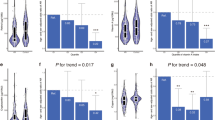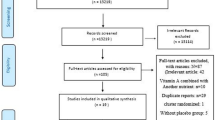Abstract
Background/Objectives:
Antioxidants and polyunsaturated fatty acids (PUFAs) have a role in the human immune defense and may affect the susceptibility to upper respiratory tract infection (URTI). To examine dietary intake of vitamin C, vitamin E, selenium, zinc and PUFAs in relation to URTI incidence in a prospective cohort study.
Subjects/Methods:
A total of 1533 Swedish women and men aged 25–64 years were followed for nine months during 2011–2012. Information on dietary intake was assessed through a web-based food frequency questionnaire, and events of URTI were self-reported prospectively as they occurred. Cox proportional hazards regression was applied to obtain incidence rate ratios with 95% confidence intervals.
Results:
The mean number of URTI events was 0.9 among all participants, 1.0 among women and 0.7 among men. In women, the incidence rate ratios (95% confidence interval) for high compared with low intake were 0.69 (0.55–0.88) for vitamin C, 0.77 (0.62–0.96) for vitamin E, 0.57 (0.39–0.83) for docosahexaenoic acid (DHA) and 0.80 (0.65-0.99) for arachidonic acid (AA). No association was found for selenium or zinc among women. In men, an increased URTI incidence was seen with medium vitamin E intake (1.42 (1.09–1.85)) and high zinc intake (1.50 (1.04–2.16)). No association was found for vitamin C, selenium or PUFAs among men.
Conclusions:
We found an inverse association of URTI incidence among women for vitamin C, vitamin E, DHA and AA intake and a positive association among men for vitamin E and zinc intake. The observed gender differences warrant further investigation.
This is a preview of subscription content, access via your institution
Access options
Subscribe to this journal
Receive 12 print issues and online access
$259.00 per year
only $21.58 per issue
Buy this article
- Purchase on Springer Link
- Instant access to full article PDF
Prices may be subject to local taxes which are calculated during checkout



Similar content being viewed by others
References
Monto AS . Studies of the community and family: acute respiratory illness and infection. Epidemiol Rev 1994; 16: 351–373.
Fendrick AM, Monto AS, Nightengale B, Sarnes M . The economic burden of non-influenza-related viral respiratory tract infection in the United States. Arch Intern Med 2003; 163: 487–494.
Shils ME SM, Ross AC, Caballero B, Cousins RJ . Modern Nutrition in Health and Disease, 10th edn. Lippincott Williams & Wilkins: Philadelphia, USA, 2006, pp 670–684.
Field CJ, Johnson IR, Schley PD . Nutrients and their role in host resistance to infection. J Leukoc Biol 2002; 71: 16–32.
Douglas RM, Hemilä H, Chalker E, Treacy B . Vitamin C for preventing and treating the common cold. Cochrane Database Syst Rev 2007; 18: CD000980.
Graat JM, Schouten EG, Kok FJ . Effect of daily vitamin E and multivitamin-mineral supplementation on acute respiratory tract infections in elderly persons: a randomized controlled trial. Jama 2002; 288: 715–721.
Meydani SN, Leka LS, Fine BC, Dallal GE, Keusch GT, Singh MF et al. Vitamin E and respiratory tract infections in elderly nursing home residents: a randomized controlled trial. JAMA 2004; 292: 828–836.
Hemila H, Virtamo J, Albanes D, Kaprio J . The effect of vitamin E on common cold incidence is modified by age, smoking and residential neighborhood. J Am Coll Nutr 2006; 25: 332–339.
Fairweather-Tait SJ, Bao Y, Broadley MR, Collings R, Ford D, Hesketh JE et al. Selenium in human health and disease. Antioxid Redox Signal 2011; 14: 1337–1383.
Huang Z, Rose AH, Hoffmann PR . The role of selenium in inflammation and immunity: from molecular mechanisms to therapeutic opportunities. Antioxid Redox Signal 2012; 16: 705–743.
Science M, Johnstone J, Roth D, Guyatt G, Loeb M . Zinc for the treatment of the common cold: a systematic review and meta-analysis of randomized controlled trials. CMAJ 2012; 184: E551–E561.
Calder PC . N-3 fatty acids and inflammatory processes. Nutrients 2010; 2: 355–374.
Alvarez Y, Valera I, Municio C, Hugo E, Padron F, Blanco L et al. Eicosanoids in the innate immune response: TLR and non-TLR routes. Mediators Inflamm 2010; 2010.
McCarthy MK, Weinberg JB . Eicosanoids and respiratory viral infection: coordinators of inflammation and potential therapeutic targets. Mediators Inflamm. e-pub ahead of print 15 May 2012 doi:10.1155/2012/236345.
Merk H, Kuhlmann-Berenzon S, Bexelius C, Sandin S, Litton JE, Linde A et al. The validity of self-initiated, event-driven infectious disease reporting in general population cohorts. PLoS One 2013; 8: e61644.
Christensen SE, Moller E, Bonn SE, Ploner A, Wright A, Sjolander A et al. Two new meal- and web-based interactive food frequency questionnaires: validation of energy and macronutrient intake. J Med Internet Res 2013; 15: e109.
Christensen SE, Moller E, Bonn SE, Ploner A, Balter O, Lissner L et al. Relative validity of micronutrient and fiber intake assessed with two new interactive meal- and web-based food frequency questionnaires. J Med Internet Res 2014; 16: e59.
National Food Agency, Swedenhttp://www7.slv.se/Naringssok/?epslanguage=sv Archived at http://www.webcitation.org/6CU63QALA (accessed on November 24 2010).
Rothman KJ, Greenland S, Lash TL . Modern Epidemiology. 3rd edn. Wolters Kluwer Health/Lippincott Williams & Wilkins: Philadelphia, USA, 2008, pp 217–218.
Willett WC, Howe GR, Kushi LH . Adjustment for total energy intake in epidemiologic studies. Am J Clin Nutr 1997; 65 (4 Suppl), 1220S–1228S; discussion 1229S–1231S.
Royston P, Sauerbrei W . Multivariable modeling with cubic regression splines: a principled approach. Stata J 2007; 7: 45–70.
Takkouche B, Regueira-Mendez C, Garcia-Closas R, Figueiras A, Gestal-Otero JJ . Intake of vitamin C and zinc and risk of common cold: a cohort study. Epidemiology 2002; 13: 38–44.
Fondell E, Balter O, Rothman KJ, Balter K . Dietary intake and supplement use of vitamins C and E and upper respiratory tract infection. J Am Coll Nutr 2011; 30: 248–258.
Bjelakovic G, Nikolova D, Gluud C . Antioxidant supplements and mortality. Curr Opin Clin Nutr Metab Care 2014; 17: 40–44.
Kurugol Z, Akilli M, Bayram N, Koturoglu G . The prophylactic and therapeutic effectiveness of zinc sulphate on common cold in children. Acta Paediatr 2006; 95: 1175–1181.
Vakili R, Vahedian M, Khodaei GH, Mahmoudi M . Effects of zinc supplementation in occurrence and duration of common cold in school aged children during cold season: a double-blind placebo-controlled trial. Iran J Pediatr 2009; 19: 376–380.
Wintergerst ES, Maggini S, Hornig DH . Contribution of selected vitamins and trace elements to immune function. Ann Nutr Metab 2007; 51: 301–323.
Chang AB, Torzillo PJ, Boyce NC, White AV, Stewart PM, Wheaton GR et al. Zinc and vitamin A supplementation in Indigenous Australian children hospitalised with lower respiratory tract infection: a randomised controlled trial. Med J Aust 2006; 184: 107–112.
Beck MA, Nelson HK, Shi Q, Van Dael P, Schiffrin EJ, Blum S et al. Selenium deficiency increases the pathology of an influenza virus infection. FASEB J 2001; 15: 1481–1483.
McKenzie RC, Rafferty TS, Beckett GJ . Selenium: an essential element for immune function. Immunol Today 1998; 19: 342–345.
Yetley EA . Multivitamin and multimineral dietary supplements: definitions, characterization, bioavailability, and drug interactions. Am J Clin Nutr 2007; 85: 269S–276S.
Klein SL . The effects of hormones on sex differences in infection: from genes to behavior. Neurosci Biobehav Rev 2000; 24: 627–638.
Klein SL, Poland GA . Personalized vaccinology: one size and dose might not fit both sexes. Vaccine 2013; 31: 2599–2600.
Falagas ME, Mourtzoukou EG, Vardakas KZ . Sex differences in the incidence and severity of respiratory tract infections. Respir Med 2007; 101: 1845–1863.
Monto AS, Sullivan KM . Acute respiratory illness in the community. Frequency of illness and the agents involved. Epidemiol Infect 1993; 110: 145–160.
Rehn M, Carnahan A, Merk H, Kühlmann-Berenzon S, Galanis I, Linde A et al. Evaluation of an Internet-based monitoring system for influenza-like illness in Sweden. PLoS One 2014; 9: e96740.
Graham NM, Douglas RM, Ryan P . Stress and acute respiratory infection. Am J Epidemiol 1986; 124: 389–401.
Hemila H . Vitamin C and common cold incidence: a review of studies with subjects under heavy physical stress. Int J Sports Med 1996; 17: 379–383.
Fondell E, Lagerros YT, Sundberg CJ, Lekander M, Balter O, Rothman KJ et al. Physical activity, stress, and self-reported upper respiratory tract infection. Med Sci Sports Exerc 2011; 43: 272–279.
Acknowledgements
This study was supported by AFA Insurances, the Swedish Council for Working Life and Social Research, and the Swedish Research Council. SER, OB, SEB and KB designed MiniMeal-Q; AP and ON designed the cohort study; SER, AP and ON collected the data; SER, OB and KB developed and validated the nutrient calculation program MiniMealCalc; OB calculated nutrient intake; SER and PS performed statistical analysis; SER, EF, PS, OB, SEB, AP, ON and KB interpreted results; S.E.R. wrote the paper and had primarily responsibility for final content; SER, EF, PS, OB, SEB, AP, ON and KB reviewed and revised the paper. All authors read and approved the final manuscript.
Author information
Authors and Affiliations
Corresponding author
Ethics declarations
Competing interests
The authors declare no conflict of interest.
Additional information
Supplementary Information accompanies this paper on European Journal of Clinical Nutrition website
Rights and permissions
About this article
Cite this article
Raposo, S., Fondell, E., Ström, P. et al. Intake of vitamin C, vitamin E, selenium, zinc and polyunsaturated fatty acids and upper respiratory tract infection—a prospective cohort study. Eur J Clin Nutr 71, 450–457 (2017). https://doi.org/10.1038/ejcn.2016.261
Received:
Revised:
Accepted:
Published:
Issue Date:
DOI: https://doi.org/10.1038/ejcn.2016.261



